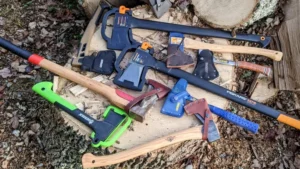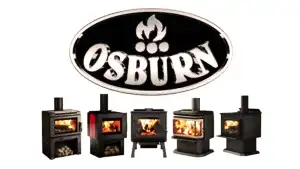Best Ways to Store Wood in Winter 2025
- September 1, 2023
- 0 comment
Winter is coming, and it’s time to get ready. If you heat your home with wood, storing it right is a must. Proper storage keeps your wood dry and ready to burn, ensuring a warm and safe home. From stacking methods to choosing the right location, every detail matters. From my own experiences, here are the best ways to store wood this winter, making sure you stay cozy through the cold months.
1. Choose the Right Wood
Choosing the right type of wood is the first critical step in ensuring a warm, efficient, and safe fire experience. The common saying, “All wood burns, but not all wood burns the same,” highlights the importance of selecting high-quality wood based on its burning characteristics, especially its heat output and burn duration.

Understanding the Heat Value of Different Woods
The heat output of wood is measured in British Thermal Units (BTU). Hardwoods, like oak and maple, generally offer higher BTU values than softwoods, meaning they burn hotter and longer. Oak is particularly valued for its density and longevity in the fire, making it an excellent choice for sustained heat. Maple, while slightly less dense than oak, also provides a high heat output and adds a pleasant aroma to the environment. Birch, including varieties like yellow birch, also delivers a good heat output and has the added benefit of its bark serving as a natural fire starter due to its oil content.
The Importance of Seasoning Wood
Seasoning wood refers to the process of drying wood over time to reduce its moisture content. Freshly cut wood, often called “green wood,” contains a lot of moisture, which can hinder its burning efficiency. When burned, green wood produces more smoke and a cooler flame as much of the heat is used to evaporate the moisture. Moreover, the moisture can lead to the production of creosote, a flammable and tar-like substance that accumulates in the chimney and poses a fire hazard. To maximize the wood’s burning efficiency and safety, it should be seasoned for at least 6-12 months, allowing it to dry until the moisture content is below 20%. This not only makes the wood easier to ignite but also ensures a cleaner, hotter burn, reducing the risk of creosote buildup in the chimney. Proper storage during this period is essential, as good air circulation significantly aids the drying process.
2. Elevate Your Firewood
Elevating your firewood off the ground is more than just a storage trick; it’s a necessary strategy for maintaining the quality and safety of your fire supply. By raising the wood, you not only avoid the direct moisture from the soil, which can “re-wet” your previously seasoned wood, but you also circumvent various storage pitfalls that can affect the burning process.

Combatting Moisture and Ensuring Quality
When firewood sits directly on moist ground, it absorbs the moisture, which reverses any drying that has occurred. This moisture retention can make the wood difficult to ignite and can cause it to burn inefficiently, producing more smoke and less heat. Additionally, moist wood is prone to developing mold and fungus, which not only potentially affects health but also diminishes the wood’s burn quality. Elevating the wood ensures that air circulates all around it, promoting faster drying times and helping maintain optimal moisture levels, which is crucial for efficient and clean burning.
Protection from Pests
Elevation also plays a crucial role in pest management. Ground-level wood is easily accessible to termites, ants, rodents, and other pests that can cause damage. By elevating the wood, you reduce the risk of pest infestation, which not only helps in preserving the integrity of your firewood but also prevents these pests from migrating closer to your home. It’s important to use a sturdy rack or platform that keeps the wood off the ground and allows for air flow beneath the stack. This setup not only deters pests but also helps keep the wood dry and ready for use, ensuring a safer and more enjoyable fire experience when you need it.
The Elevated Solution
Elevating your firewood is a straightforward yet critical step for ensuring its longevity, burning efficiency, and overall safety. The height to which you elevate your wood can significantly impact these factors, and there are a couple of effective methods to achieve this with varying heights and materials.
Wood Racks
Wood racks are an excellent option for keeping your firewood off the ground. These structures are specifically designed to promote optimal airflow and prevent moisture from seeping into the wood from below. Available in materials like metal or treated wood, which resist weathering and decay, wood racks ensure consistent elevation. They also provide the added benefit of organization, keeping your firewood neatly stacked and ready to use. Investing in a quality wood rack from a reputable supplier can be a wise decision for anyone looking to maintain a clean and efficient firewood storage system.
Wooden Pallets
For those who prefer a more hands-on, cost-effective solution, wooden pallets can be an excellent alternative. Pallets are generally easy to acquire and can be configured to support large stacks of wood, making them a practical choice for bulk storage. When using pallets, it’s crucial to ensure they are free from rot and structural damage to maintain the integrity of your firewood stack. Stacking wood on healthy, sturdy pallets elevates it sufficiently to prevent moisture absorption and pest invasion.
Optimal Elevation Height
Raising your firewood even a few inches off the ground—typically between six inches to one foot—is usually enough to protect it from moisture and pests. This height allows air to circulate underneath the stack, speeding up the drying process and reducing the likelihood of mold and decay. The choice between using a wood rack and pallets largely depends on your specific storage needs, budget, and personal preference. Both options, when implemented correctly, can significantly improve the condition and usability of your firewood, making your fires warmer and your wood-burning experience more enjoyable.
3. Keep It Covered, But Not Completely
Storing firewood effectively involves a delicate balance between protection from the elements and maintaining adequate ventilation. Here’s how to keep your wood dry and ready for burning without stifling its necessary exposure to air.

Guarding Against the Elements
Rain and snow are major culprits in increasing the moisture content of firewood, which can undermine the drying process and lead to inefficient, smoky fires. Conversely, too much sunlight can overly dry the wood, making it brittle and quick to burn. The solution lies in using covers that protect while allowing the wood to breathe.
Covering Solutions
Waterproof Tarps
An accessible option for many, waterproof tarps can be draped over the woodpile to protect against moisture. It’s important to cover just the top and partially down the sides, ensuring the stack isn’t entirely enclosed. This method allows for moisture protection while still promoting airflow. Securing the tarp with weights or ropes is crucial to keep it in place during windy conditions.
Wood Storage Sheds
For a more permanent solution, a wood storage shed can provide excellent protection from rain and snow. Opt for sheds that incorporate design features enhancing ventilation, such as vents or spacing in the construction materials. These structures offer a reliable barrier against the elements while supporting the ongoing drying process of the wood.
The Need for Ventilation
Ventilation is crucial not only for continuing the seasoning process but also for preventing mold and fungi, which thrive in damp, unventilated environments. Moldy wood is inefficient to burn and poses health risks due to spore release when burned.
Practical Tips for Balanced Coverage
- Top-Covering: Primarily cover the top of your woodpile. This tactic shields the wood from direct rainfall and snow while leaving the sides open to promote air circulation.
- Elevate the Stack: Combine top-covering with elevation. As discussed earlier, elevation prevents moisture from wicking up from the ground and assists in better air circulation around the wood.
- Monitor and Adjust: Regularly inspect your woodpile. If signs of excessive moisture or mold appear, adjust your coverage strategy. This could mean repositioning the tarp for better coverage or modifying the airflow in a shed setup.
4. Location, Location, Location
The wisdom of “location, location, location” applies just as much to firewood storage as it does to real estate. Choosing the right spot to store your wood can significantly influence its readiness for use, ease of access, and overall condition.

The Proximity Principle
Having your firewood close enough to your home enhances convenience and safety, especially during the harsh winter months. This proximity allows for quick trips to replenish your fire’s fuel, minimizing exposure to the cold and reducing the risk of accidents on icy paths. However, there’s a delicate balance to maintain:
But Not Too Close…
While proximity is essential, pushing your woodpile directly against your home might not be the best idea. Here’s why:
Pests
Woodpiles attract insects and rodents, which can easily find their way into your home if the wood is too close. This is particularly critical with termites, which can cause structural damage.

Moisture
Firewood can hold moisture, which might seep into your home’s walls if stored too closely, potentially leading to mold growth and damage to exterior siding.

The Sunlight Factor
Moderate exposure to sunlight can greatly benefit your firewood storage strategy:
- Natural Drying: Even if your wood is seasoned, a bit of sunlight can help in keeping it dry, especially after a rain or snowfall. Sunlight acts as a natural dehumidifier, reducing the moisture content of the outer layers of the wood.
- Warmth: A location that gets sunlight can prevent the woodpile from becoming overly cold. This can be especially helpful in ensuring your wood remains slightly warmer, making it easier to ignite when brought indoors.
Striking a Balance
Here are a few tips to find the optimal location for your firewood:
- Optimal Side: Storing wood on the south or west side of your property can be beneficial due to the increased sunlight exposure these areas typically receive.
- Distance from Home: Keeping the woodpile 20-30 feet away from your home strikes a balance between accessibility and safety, keeping pests and moisture issues at bay.
- Visibility: Choose a storage spot that is easily visible from a window or door of your home. This not only allows you to keep an eye on the woodpile but also helps in monitoring your stock levels conveniently.
By carefully selecting the location for your firewood, you ensure it remains dry, easy to access, and free from pests, all while minimizing any potential risks to your home. This strategic placement enhances both the functionality and safety of your firewood storage.
5. Stack Smartly
Smart stacking of firewood is essential for maintaining its quality and safety. Proper stacking methods can significantly impact the wood’s seasoning process, its protection from pests and mold, and the safety of accessing the logs.

The Role of Airflow
When it comes to firewood storage, airflow isn’t merely beneficial—it’s vital. Good airflow plays a dual role:
- Accelerated Drying: Continuous airflow helps in the evaporation of residual moisture from the wood, which is crucial even for seasoned wood, ensuring it remains efficient for burning.
- Mold Prevention: A stack with insufficient airflow can trap moisture, creating a damp environment ripe for mold and fungi growth. Moldy wood is less efficient to burn and, when ignited, can release spores into the air, which can be harmful when inhaled.
Crisscross vs. Rows
Crisscross Pattern
Often referred to as “log cabin” stacking, this method involves placing logs perpendicular to each other in alternating layers. The resulting structure promotes excellent airflow and is particularly useful for seasoning freshly cut wood. Additionally, the crisscross pattern is often more stable than randomly piled wood.

Row Stacking
When stacking wood in rows, ensure there’s enough space between each log. Spacing the logs not only promotes drying but also makes the stack less attractive to pests, who prefer tight, dark spaces.

Height and Stability
While it might be tempting to create towering stacks to maximize storage, safety must always be a priority.
- Avoid Over-Stacking: Very high stacks can become unstable, especially if the logs aren’t uniformly cut. An unstable stack not only poses a risk of falling logs, which can be hazardous, but it can also collapse, undoing all your stacking efforts.
- Anchor the Ends: To enhance stability, consider creating robust end pillars or “bookends” for your stack. This involves placing logs perpendicular to the primary direction of the stack, forming a sturdy boundary.
- Ground Check: Ensure the ground where you’re stacking is relatively level. Stacking on uneven terrain can compromise the stability of the pile.
6. Rotate Your Stock
Rotating your firewood stock is akin to managing a pantry: knowing what to use first ensures maximum efficiency and quality. By systematically using older wood before newer additions, you optimize each fire for warmth and efficiency while avoiding potential problems associated with aging wood.

Understanding Wood Aging
Wood undergoes several changes as it sits in storage:
- Drying Process: When freshly cut, wood contains a lot of moisture. Over time, if stored correctly, this moisture gradually evaporates, making the wood more suitable for burning.
- Combustion Efficiency: Drier wood combusts more efficiently. It ignites more easily, burns hotter, and produces less creosote, a tar-like substance that can accumulate in chimneys and pose a fire risk.
- Risk of Decay: While seasoning is a desirable form of aging for wood, it’s not the only change the wood undergoes over time. Wood that sits for too long, especially in conditions with inadequate airflow or protection from moisture, can start to decay or develop mold.
First In, First Out (FIFO) Principle
Derived from inventory management, the FIFO principle can be seamlessly applied to firewood:
- Maximizing Efficiency: By burning the oldest wood first, you ensure that you’re using the wood at its optimal burning point, capitalizing on its reduced moisture content and enhanced combustion efficiency.
- Preventing Decay: Consistently using the oldest logs ensures that no batch of wood sits in storage for an overly extended period, thereby reducing the chances of decay or mold growth.
- Streamlined Storage: Adopting a FIFO approach can also make storage management easier. You’ll have a clearer idea of where to add new wood and where to draw older wood from, creating a cycle of wood movement that maximizes storage efficiency.
7. Stay Vigilant Against Pests
As winter draws near, not only do we seek warmth and comfort indoors, but so do many pests, seeing your woodpile as a perfect refuge. Vigilance is key to maintaining a pest-free stack of firewood. By implementing strategic measures, you can prevent your woodpile from becoming a winter haven for unwanted guests.

The Allure of Woodpiles for Pests
Firewood stacks offer a trifecta of attractions for pests:
- Shelter: The spaces between logs provide an ideal hiding spot, shielding pests from predators and the elements.
- Warmth: Wood retains heat, making it a cozy sanctuary during chilly days and nights.
- Food Source: For wood-boring insects, the woodpile is not just a home but a buffet.
Signs of Infestation
Detecting pests early can make all the difference. Keep an eye out for:
- Small Holes: These could indicate wood-boring insects, such as beetles or termites, making their way through your logs.
- Sawdust Piles: Also known as frass, these small piles are often left behind by insects boring into or eating the wood.
- Audible Noises: A faint scratching or rustling sound can indicate the presence of larger pests like rodents.
- Visual Evidence: Regularly inspect your woodpile for live pests, larvae, or even nests. Some pests, like carpenter ants, might be visibly scurrying over the wood.
Preventive and Responsive Measures
- Regular Inspection: Set a routine (e.g., once a week) to inspect your woodpile. Catching signs of infestation early can prevent a full-blown pest invasion.
- Move Affected Wood: If you detect an infested section, relocate that batch of wood away from the main pile. This helps contain the issue and prevents it from spreading.
- Natural Repellents: There are several natural substances that deter pests. For instance, diatomaceous earth can be sprinkled around the woodpile to ward off insects. Additionally, essential oils like eucalyptus or peppermint can deter certain pests.
- Elevate Your Stack: As mentioned earlier, elevating your wood off the ground can deter many ground-based pests from taking residence.
- Avoid Pesticides: While it might be tempting, avoid spraying conventional pesticides on your woodpile. These chemicals can release toxic fumes when the wood is burned.
8. Measure Moisture Levels
For the casual fireplace user, a piece of wood may just seem ready to be thrown into the fire and lit up. However, the seasoned wood burner knows there’s more to the tale. The moisture content of the wood plays a pivotal role in how effectively and cleanly it will burn. In an era where precision is cherished, the use of a moisture meter in gauging the readiness of firewood is becoming increasingly popular. Let’s dive deeper into the importance of measuring moisture levels in firewood and the role of the moisture meter in this process.

Moisture and Its Impact on Burning
- Energy Efficiency: The wetter the wood, the more energy is spent on evaporating the moisture, rather than producing heat. Dry wood, with its low moisture content, combusts more efficiently, producing more heat per log.
- Creosote Production: Burning wet wood can lead to the release of unburned tar vapors, which can condense inside the chimney, forming creosote. This tar-like substance is not only a fire hazard but also necessitates regular chimney cleaning.
- Smoke and Emissions: Wet wood tends to produce more smoke and emissions, which can be harmful to the quality of your home.
The Role of the Moisture Meter
A moisture meter is a handheld device designed to measure the moisture content of various materials, including wood. For those serious about their firewood, it’s an indispensable tool.
- Precision: While experienced wood burners might rely on tactile or auditory clues (like a distinctive “clink” sound when two pieces of dry wood are knocked together) to gauge wood’s dryness, a moisture meter offers a precise percentage.
- Ease of Use: Modern moisture meters are user-friendly. Simply insert the probes into the firewood, and the device will provide a reading. Some models even offer color-coded indicators for quick assessments.
- Cost-Effective: By ensuring that you’re only burning optimally dry wood, you’re getting the most heat value out of every log. Over time, this efficiency can translate to savings.
While readings can vary slightly depending on the specific species of wood, a general guideline is:
- Above 30%: Too wet. This wood needs more seasoning.
- 20-30%: On the cusp. While it can be burned, it might not provide the best combustion efficiency.
- Below 20%: Ideal. This wood has been seasoned well and is ready for a clean, efficient burn.
9. Keep Safety in Mind
Winter’s charm often includes the warm, inviting scene of a wood-burning fireplace, enhancing the cozy atmosphere of your home. However, to ensure these serene moments are safe and enjoyable, it is crucial to adopt prudent firewood storage practices. Let’s explore the essential measures that safeguard your home and loved ones from potential hazards associated with storing firewood.

Indoor Storage Risks
- Fire Hazard: While it might seem convenient to have a generous pile of wood right next to the fireplace, storing large quantities inside can pose a significant risk. Not only can stray sparks ignite the pile, but wood also releases volatile organic compounds (VOCs) which, in large concentrations, can be flammable.
- Pest Introduction: Firewood can harbor pests. By storing large amounts indoors, you run the risk of introducing wood-boring insects, spiders, and even rodents into your living space.
Child Safety and Woodpiles
Children, with their boundless energy and curiosity, can inadvertently turn a woodpile into a playground. This poses two primary concerns:
- Unstable Piles: A hastily or poorly stacked pile can be unstable. If children climb or play around it, the logs can dislodge, potentially leading to injuries.
- Splinters and Pests: Logs can be rough, with splinters and hidden pests. Children playing with or around wood can get splinters or come into contact with insects.
Safety Precautions
- Limited Indoor Storage: If you prefer the convenience of indoor storage, limit the quantity. Store just enough for immediate use, and regularly replenish from your main outdoor stock.
- Stable Stacking: Ensure that your woodpile, whether indoors or outdoors, is stable. Using a crisscross pattern or leaving spaces between logs can help, but always check the pile’s stability by gently nudging it.
- Childproofing: If you have young ones, consider using barriers or cordoning off the wood storage area. Educate older children about the risks associated with playing near the woodpile.
- Regular Inspections: Periodically inspect your woodpile for any signs of instability, decay, or pest infestation. Address issues promptly to maintain a safe environment.
All in all Conclusion
As winter 2025 approaches, the allure of a crackling wood fire becomes increasingly irresistible, promising warmth and a cozy ambiance during the chilly months. By investing the time and effort into storing your firewood properly, you’re not just preparing for warmth; you’re ensuring safety, efficiency, and reliability throughout the season. So, take a page from a seasoned wood burner’s book and set yourself up for success. Properly stored and managed firewood means you can enjoy the beautiful, comforting glow of a wood fire all winter long, enhancing the seasonal charm and making those cold nights significantly more bearable and stylish.
FAQs
- Why does winter wood storage differ from other seasons?
The winter season poses unique challenges like snow, excess moisture, and freezing temperatures, which can affect the quality of your firewood. Proper winter storage ensures that the wood remains dry and ready for burning. - Can snow on my woodpile benefit the seasoning process?
While a light covering of snow might not harm the wood, prolonged exposure to snow can introduce moisture. It’s best to brush off any snow and ensure the top of the pile remains covered. - Are there any woods that season faster in colder climates?
While the cold doesn’t necessarily speed up the seasoning process, woods like ash or pine tend to dry out faster than hardwoods like oak, regardless of the climate. - Is it true that frozen wood burns slower?
Wood that’s frozen will take longer to ignite and may produce less heat initially. However, once the moisture from the ice is evaporated, it should burn at its typical rate. - How can I tell if my wood is too damp from winter weather to burn effectively?
Apart from using a moisture meter, damp wood is typically heavier, might have a damp smell, and can sizzle or produce excessive smoke when burning. - Does frost affect the quality of firewood?
Frost itself isn’t harmful, but if the wood is repeatedly subjected to thawing and freezing, the moisture content can fluctuate, potentially affecting burn quality. - What’s the ideal storage solution for areas with heavy snowfall?
Elevating the wood and using a storage shed with proper ventilation can protect the wood from deep snow while allowing airflow. - Can I use snow as a natural repellent against pests?
While snow might deter some pests, it’s not a reliable repellent. In fact, snow can create a moist environment that some pests might find attractive once it starts melting. - How can I optimize my wood storage location to benefit from winter sunlight?
Storing your wood in a location that receives direct sunlight can help in naturally drying out any moisture. South-facing spots are often ideal in the Northern Hemisphere. - Are there any natural winter phenomena that can help in seasoning wood?
Winter winds can be a boon for seasoning. If your storage area receives good airflow, the winter breeze can aid in drying out the wood faster.
We’re eager to learn from you! Feel free to discuss your own winter wood storage methods and reflections in the space provided below. Your valuable insights have the potential to assist others in making well-informed choices when it comes to storing wood during the winter of 2025.


















Leave your comment